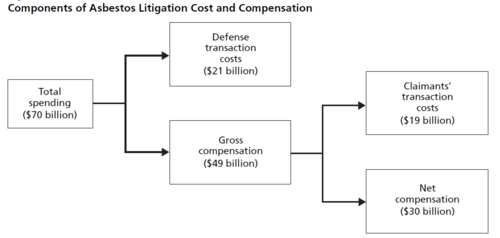Asbestos Litigation
A 2005 RAND report states that asbestos litigation arose as a result of millions of individuals’ exposure to asbestos and as a result of many asbestos product manufacturers’ failure to protect workers against exposure and failure to warn their workers to take adequate precautions against exposure. The history of the litigation has been shaped by the rise of a sophisticated and well-capitalized plaintiff bar, heightened media attention to litigation, and the information technology revolution.
According to the RAND report:
- At least 8,400 entities have been named as asbestos defendants through 2002.
- Defendants are distributed across most U.S. industries.
- Total spending on asbestos litigation through 2002 was about $70 billion, broken down as set out in the diagram below.

FLSA Litigation
The Fair Labor Standards Act (FLSA) is the federal law of broadest application governing minimum wage, overtime pay, and youth employment. Employees who are covered by the FLSA are entitled to be paid at least the Federal minimum wage as well as time and one-half their regular rates of pay for all hours worked over 40 in a workweek, unless an exemption applies.
Although FLSA litigation can involve a variety of claims, two of the most common are misclassification claims—i.e., allegations that an employer has misclassified an employee, or a group of employees, as exempt from the FLSA’s overtime requirements—and “off-the-clock” claims—i.e., allegations that an employee, or group of employees, has not been paid for all of the time they worked for the employers.
These and other claims under the FLSA can be brought individually or on behalf of all “similarly situated” employees and former employees. As a result, FLSA cases can involve a large number of employees and present significant financial exposure for employers. For instance, in 2008 Walmart agreed to pay as much as $640 million to settle 63 federal and state class actions claiming the company cheated hourly workers and forced them to work through breaks.
The multitude of wage and hour claims and lawsuits that workers have filed under the FLSA, and its state law counterparts, have made wage and hour law the nation’s fastest growing type of litigation. All industries (including retail, financial services, hospitality, construction, technology, and communications) have been susceptible to these lawsuits.
As shown in the graph to the left, the number of wage and hour lawsuits increased significantly over the past reporting year to 8,126, up another 4.7% over the prior 12-month period.
This is the seventh straight year of increases in federal court wage and hour lawsuits and ups the continuing explosion in these cases over the past decade to 237% and since 2000 to 438%.
Employment Testing Litigation
Employment testing litigation will have many parallels with asbestos and FLSA litigation, but on an even larger scale.
There are potentially tens of millions of plaintiffs
- Any person who takes an assessment, if the assessment is determined to be a medical examination will be a plaintiff. Appellate courts have held consistently that the prohibition on medical examinations extends to all persons, including persons who are not disabled (see, e.g., decisions from the Second, Sixth, Eighth, Tenth and Eleventh Circuits).
- Any class of disabled persons (i.e., those with mental illness) where the assessment tends to screen out those persons from employment consideration. Unlike disparate impact claims under other employment discrimination laws the ADA does not require statistical evidence if an expert can confirm that the test would screen out persons with disabilities or categories of disabilities.
- Federal and state agencies seeking to recover billions of dollars spent on SSDI/SSI disability awards, Medicare/Medicaid and other costs expended on persons who were illegally and invidiously discriminated against as a consequence of the use of employment assessments.
There are potentially hundreds of thousands of defendants
- Employers utilizing testing will face claims by (A) applicants and employees for both the illegal use of a pre-employment medical examination and the failure to treat information obtained from such medical examination as confidential medical information, (B) federal and state agencies seeking recovery of costs incurred (disability awards, Medicare/Medicaid, etc.) as a consequence of the illegal testing, (C) claims by insurers denying coverage and (D) claims by testing companies denying liability/rejecting indemnification.
- Testing companies will face claims by (A) applicants whose information was not treated as confidential medical information (a separate cause of action that does not require exhausting of remedies with the EEOC), (B) employers seeking indemnification from the testing companies for claims made against the employers by applicants, government agencies and others, and (C) claims by insurers denying coverage.
- Insurance companies who underwrite policies for employers and testing companies will face claims from those they insure as well as individuals and government agencies making claims against those employers and testing companies.
Costs to employers, testing companies and their insurers will be in the tens (if not hundreds) of billions of dollars, including:
- Defense transaction costs, including the costs of outside counsel, internal management and employee time, public relations, lobbying, etc.
- Gross compensation, including awards to applicants and payment of costs and fees (i.e., counsel, expert witnesses, e-discovery).
- Reputational damage costs, including lost/reduced sales and brand damage.
- Business restructuring and/or “disinfectant” costs – The employers and testing companies retention and use of confidential medical information in violation of the ADA safeguards has resulted in the applications and solutions that illegally use this data. The data derived from the hundreds of millions of assessments over the past years has created a virus that has "infected" the employer and testing company solutions that integrate this data.


No comments:
Post a Comment
Because I value your thoughtful opinions, I encourage you to add a comment to this discussion. Don't be offended if I edit your comments for clarity or to keep out questionable matters, however, and I may even delete off-topic comments.